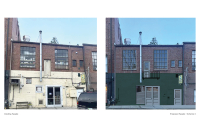App brings art to the people – and their smart phones
For those looking to learn more about the sculptures that dot the campus at Western Carolina University, well, there’s an app for that. Or at least there will be soon, thanks to a collaboration between the school’s Fine Arts Museum and Computer Information Systems students in the College of Business.
As a part of a class, now one of the major’s capstone courses, students are building a mobile application that will guide users on an audio-visual tour of the pieces that comprise the school’s public art program.
It’s an idea that really excites the Denise Drury. She’s the museum’s interim director, and she’s stoked about bringing art to the public.
“I’ve always been really passionate about public art because I feel like it’s kind-of a gateway,” said Drury. “A lot of people get into art by seeing it outside.”
She hopes that adding an app to the school’s public-art approach, it’ll entice a whole new demographic into the museum and into interaction with the arts.
The school has run a public art program in some incarnation since the 80s, said Drury, ranging from specifically purchased pieces that find their permanent homes somewhere on campus to regional art competitions whose winners display their creations temporarily at the university.
Related Items
Currently, the school has nine outdoor sculptures gracing the Cullowhee campus, as well as an indoor, two-dimensional sculpture that hangs permanently in the school’s Belk building.
Included in that number are the winners from a contest last fall that stand sentry in the courtyard outside the school’s Fine and Performing Arts Center.
The goal of the proposed app is to curate these works, giving students, faculty and visitors an interactive arts experience on their own terms and timeline.
Currently, Drury said they’re working on two different content styles – one a richer, more descriptive tour that would include a detailed explanation of the artwork, background information on the artist and their creation, and possibly even commentary from the artists themselves.
The idea is to pack the app with information for off-site users who aren’t standing in front of the works.
“We feel like this is a very good program for people who might not be able to make it to the campus,” said Drury.
But they’re hoping to build in some unique features for on-campus art lovers, too, including a GPS locater that will guide users from one sculpture to the next, highlighting their distance from the various public art pieces.
“It’s just an added incentive to get people out and walking on campus, people who visit Western for football games and are tailgating, people who are coming for a performance and get here a little early,” said Drury, as well as the thousands of students and faculty who pass the sculptures every day.
Associate Professor Dan Clapper is one of them. He teaches the app-writing class, only in its second semester, and he, too, thinks the possibility of new ways to interface with art is an intriguing.
“As a faculty member here, I drive by a lot of those sculptures everyday and I’m curious about them,” said Clapper.
His student team who are working with Drury and her staff to create the app are, said Clapper, treading new territory in how to convey that information, though.
“It’s all kind of new for us, I think it’s new for people in general,” said Clapper. “We don’t really know how long people want to listen to an audio clip when they’re standing in front of a sculpture.”
And that’s where testing comes into play. Drury and her staff provide the content for the app, while the students find a way to make that content work. But there are a multitude of options for introducing users to art. Should there be detailed descriptions? A bank of photos? Artist profiles? Art history information? Will people want to stand in front of a sculpture listening for 30, 60, 90 seconds?
These are all answers that student testing will hopefully answer. And at the end of the process, the result will not only be a great app, but a cadre of students who have hands-on experience in a marketable arena that everyone from museums to fast-food restaurants want to get in on.
From the educational side, Drury said she’s thrilled to be embracing technology and bringing learning to people on their terms.
“It’s something that a lot of our colleagues are doing in the arts, so we feel like it’s a natural progression for us,” said Drury. “A lot more people are buying smart phones and using them as learning tools.”
From a technological perspective, the app-writing class is pretty cutting edge, and Clapper sees it as an exciting technology that’s only going to get bigger.
“I think it’s a technology that’s really just starting to take off, and as more and more people start to have smart phones, we‘ll see a lot more applications,” said Clapper.
This semester, the class is also working on an app for the Catawba County government, the Mountain Heritage Center and a continuing project that will map out a tour of Cherokee history.
The Fine Art Museum app should be available by early summer.









